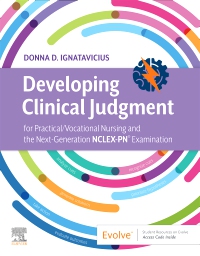
Developing Clinical Judgment for Practical/Vocational Nursing and the Next-Generation NCLEX-PN® Examination - Elsevier E-Book on VitalSource, 1st Edition
Elsevier eBook on VitalSource

Now $37.79
Get ready to pass the Next-Generation NCLEX-PN® Examination (NGN-PN) on your first try with Developing Clinical Judgment for Practical/Vocational Nursing and the Next-Generation NCLEX-PN® Examination. Written by renowned nursing education expert Donna D. Ignatavicius and a team of expert item writers, this practical workbook focuses on developing the clinical reasoning skills you need to succeed on the NGN-PN and in clinical practice. This collection of engaging and practical thinking exercises has been carefully developed to incorporate the National Council of State Boards of Nursing (NCSBN) Clinical Judgment Measurement Model (CJMM) and to emphasize the new item types that will be integral to the NGN-PN. Exercises range from basic to more complex and address all key content areas to fully prepare you for all facets of the exam. This "next-generation" workbook will become an invaluable companion throughout nursing school, helping you grow your clinical reasoning skills to match what’s expected on the NGN-PN!
Newer Edition Available
Developing Clinical Judgment for Practical/Vocational Nursing and the Next-Generation NCLEX-PN® Examination - Elsevier E-Book on VitalSource
-
- Innovative workbook format helps you prepare for the Next-Generation NCLEX-PN® Exam (NGN-PN) through practical thinking exercises that challenge you to apply the National Council of State Boards of Nursing (NCSBN) Clinical Judgment Measurement Model to common clinical scenarios
- A comprehensive collection of carefully developed clinical reasoning exercises range from basic to more complex and address all key content areas.
- Logical three-part organization:
- Part 1 is an introduction to clinical judgment with examples of how to approach the thinking exercises in the workbook
- Part 2 consists of exercises that focus on applying clinical judgment for clients across the lifespan experiencing commonly occurring physical and mental health problems
- Part 3 consists of exercises that focus on applying clinical judgment for older-adult clients, a main focus of care for LPN/LVNs
- A robust quizzing engine on the companion Evolve website features all of the book’s questions in an interactive format to provide a realistic simulated test-taking experience and feedback for remediation
- An extensive answer key with detailed rationales provides essential review and remediation
-
Part 1. Introduction: Developing Clinical Judgment
1. The Use of Clinical Judgment in Practical/Vocational Nursing Practice
2. How to Apply Clinical Judgment Models to Ensure Client Safety
Part 2. Clinical Judgment for Clients Across the Lifespan Experiencing Commonly Occurring Health Problems
3. Perfusion:
Bradycardia/Pacemaker (middle-age adult)
Heart Failure (middle-age adult)
4. Clotting: Deep-Vein Thrombosis (middle-age adult)
5. Gas Exchange:
Asthma (school-age child)
COPD (middle-age adult)
6. Elimination
Benign Prostatic Hyperplasia/TURP (older adult)
Ulcerative Colitis/Colostomy (middle-age adult)
Appendicitis/Appendectomy (adolescent)
7. Nutrition:
Cholecystitis/Cholecystectomy (young adult)
Peptic Ulcer Disease (middle-age adult)
8. Mobility:
Sports Injury (school-age child)
Fractured Arm/Cast Care (preschool-age child)
9. Metabolism:
Diabetes Mellitus (middle-age adult)
Hypothyroidism/Thyroidectomy (middle-age adult)
10. Cellular Regulation: Breast Cancer/Mastectomy (young adult)
12. Infection:
Cellulitis (young adult)
RSV (toddler)
14. Mood and Affect: Depression (adolescent)
15. Stress and Coping:
Generalized Anxiety Disorder (young adult)
Substance Use Disorder (adolescent)
16. Reproduction:
Uterine Leiomyoma/Hysterectomy (middle-age adult)
Healthy Pregnancy
Intrapartum Care
Postpartum Care
Healthy Newborn Care
Part 3. Clinical Judgment to Coordinate Care for Older Clients
17. Perfusion:
Hypertension
Stroke
18. Mobility:
Parkinson’s Disease/Preventing Complications of Immobility
Osteoarthritis/Total Knee Arthroplasty
Fractured Hip/ORIF
19. Sensory Perception: Cataract
20. Infection: Pneumonia
21. Cognition:
Delirium
Alzheimer’s Disease
22. Elimination:
Chronic Kidney Disease
Bowel Obstruction
23. Metabolism:
Hypoglycemia
Cirrhosis
24. Coordinated Care:
Establishing Priorities
Collaborating with the Interprofessional Healthcare Team
Participating in Quality Improvement Activities
Answer Key (with detailed rationales, faculty only, Evolve)
Interactive NGN Review Questions (student, Evolve)



 as described in our
as described in our 